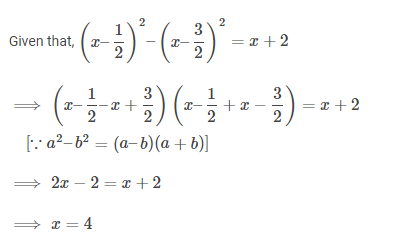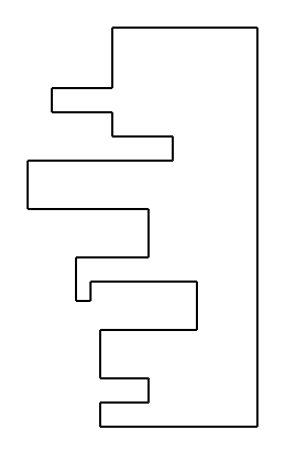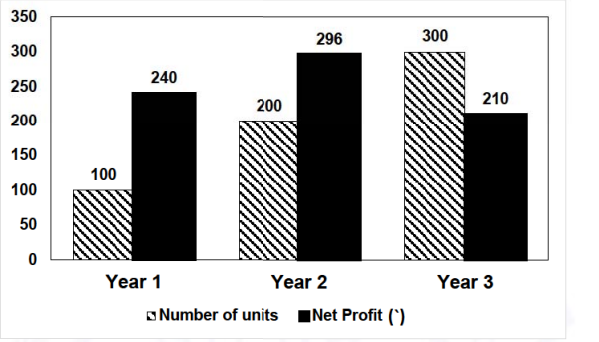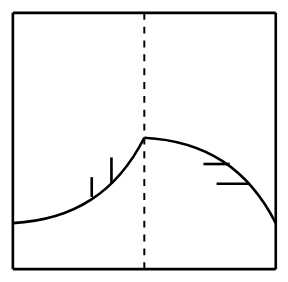Graduate Aptitude Test in Engineering
Date: 13th Feb 2021
Session: Evening
General Aptitude (GA)
Q.1 – Q.5 Carry ONE mark each.
Q. 6 – Q. 10 Carry TWO marks each.
Q.1 Gauri said that she can play the keyboard __________ her sister.
(A) as well as
(B) as better as
(C) as nicest as
(D) as worse as
Ans: (A) as well as
Solution: as nice as, as good as, as well as, as perfect as, as cute as, as joyful as, as pretty as. All will fit in, as all are in their FIRST degree.
Q.2
A transparent square sheet shown above is folded along the dotted line. The folded sheet will look like ___________.

Ans: (B)
Q.3 If θ is the angle, in degrees, between the longest diagonal of the cube and any one of the edges of the cube, then, cosθ=
(A) 1/2
(B) 1/√3
(C) 1/√2
(D) √3/2
Ans :(B) 1/√3
Solution:

Q.4 If (x–1/2)2–(x−3/2)2=x+2, then the value of x is:
(A) 2
(B) 4
(C) 6
(D) 8
Ans: 4

Q.5 Pen:Write :: Knife: ?
Which one of the following options maintains a similar logical relation in the above sentence?
(A) Vegetables
(B) Sharp
(C) Cut
(D) Blunt
Ans: (C) Cut
Q6: Listening to music during exercise improves performance and reduces discomfort. Scientists researched whether listening to music while studying can help students learn better and the results were inconclusive. Students who needed external stimulation for studying fared worse while students who did not need any external stimulation benefited from music.
Which one of the following statements is the CORREC inference of the above passage?
(A) Listening to music has no effect on learning and a positive effect on physical exercise
(B) Listening to music has a clear positive effect both in physical exercise and on learning
(C) Listening to music has a clear positive effect on physical exercise. Music has a positive effect on learning only in some students
(D) Listening to music has a clear positive effect on learning in all students. Music has a positive effect only in some students who exercise
Ans: (C) Listening to music has a clear positive effect on physical exercise. Music has a positive effect on learning only in some students
Q7:

A jigsaw puzzle has 2 pieces. One of the pieces is shown above. Which one of the given options for the missing piece when assembled will form a rectangle? The piece can be moved, rotated or flipped to assemble with the above piece.

Ans: (A)
Q.8 The number of students in three classes is in the ratio 3:13:6. If 18 students are added to each class, the ratio changes to 15:35:21. The total number of students in all the three classes in the beginning was:
(A) 22
(B) 66
(C) 88
(D) 110
Ans: (C) 88
Solution: Let the three classes have 3x, 13x and 6x students respectively.
18 students are added in each class.
After that 3x+18,13x+18 and 6x+18 are the number of students in each class.
Given, (3x+18):(13x+18):(6x+18)=15:35:21
⟹(3x+18): (6x+18)=15: 21
⟹(x+6) : (2x+6)=5 : 7
⟹7x+42=10x+30
⟹3x=12
⟹x=4
So, the total number of students in all the three classes, in the beginning, =3∗4+13∗4+6∗4=88
Q 9: The number of units of a product sold in three different years and the respective net profits are presented in the figure above. The cost/unit in Year 3 was ₹1, which was half the cost/unit in Year 2. The cost/unit in Year 3 was one-third of the cost/unit in Year 1. Taxes were paid on the selling price at 10%, 13% and 15% respectively for the three years. Net profit is calculated as the difference between the selling price and the sum of cost and taxes paid in that year. The ratio of the selling price in Year 2 to the selling price in Year 3 is _________.

(A) 4:3
(B) 1:1
(C) 3:4
(D) 1:2
Ans: (A) 4:3
Solution:

Q10 Six students P, Q, R, S, T and U with distinct heights, compare their heights and make the following observations.
- Observation I: S is taller than R
- Observation II: Q is the shortest of all.
- Observation III: U is taller than only one student.
- Observation IV: T is taller than S but is not the tallest
The number of students that are taller than R is the same as the number of students shorter than ____________.
(A) T
(B) R
(C) S
(D) P
Ans: (C)
Solution:
- S is taller than R.
So, S>R - Q is the shortest of all.
So, we have
∗,∗,∗,∗,∗,Q - U is taller than only one student.
So, U is second tallest. Hence,
∗,∗,∗,∗,U,Q - T is taller than S but not tallest.
T is taller than S implies T>S.
- From observations i and iv, we have T>S>R.
- But it is mentioned that T is not the tallest person.
So, ∗,T,S,R,U,Q
Since, we have only one student P left, we fill the blank with P
P,T,S,R,U,Q
Now, no of students taller than R=3=No of students Shorter than S
